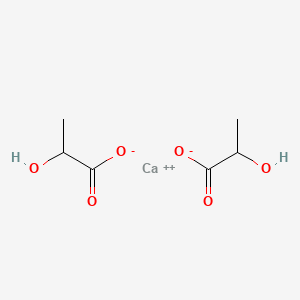



1. Ca Lactate
1. 814-80-2
2. Calcium Dilactate
3. Calphosan
4. Hemicalcium L-lactate
5. Lactic Acid, Calcium Salt (2:1)
6. Calcium;2-hydroxypropanoate
7. Calcium 2-hydroxypropanoate
8. Propanoic Acid, 2-hydroxy-, Calcium Salt (2:1)
9. 2-hydroxypropanoic Acid Calcium Salt
10. 5743-48-6
11. Calcium Lactate Anhydrous
12. Calcium 2-hydroxypropanoate (1:2)
13. 63690-56-2
14. Calcium (as Lactate)
15. Calcium Bis(2-hydroxypropanoate)
16. Calcium Lactate, Anhydrous
17. Ins No.327
18. 28305-25-1
19. 2urq2n32w3
20. Ins-327
21. Ins-327-
22. Dsstox_cid_236
23. Conclyte Calcium
24. E-327
25. Dsstox_rid_75451
26. Dsstox_gsid_20236
27. Ca Lactate
28. Cas-814-80-2
29. Calcium Lactate [usan:jan]
30. Ccris 3669
31. Hsdb 976
32. Einecs 212-406-7
33. Unii-2urq2n32w3
34. Ai3-04468
35. Calcium Dl-lactate
36. Einecs 227-266-2
37. Calcium Lactate [ii]
38. Calcium Lactate [mi]
39. Calcium Lactate [fcc]
40. Calcium Lactate [hsdb]
41. Calcium Lactate [inci]
42. Calcium Lactate (1:2)
43. Calcium Lactate [vandf]
44. Ec 212-406-7
45. Calcium Lactate [who-dd]
46. Schembl4319
47. Calcium (as Lactate) [vandf]
48. Chembl2106111
49. Dtxsid0020236
50. Hy-b2227a
51. Calcium Lactate [usp-rs]
52. Lactic Acid Calcium Salt (2:1)
53. Amy37027
54. Tox21_201378
55. Tox21_302896
56. Bis(2-hydroxypropanoic Acid) Calcium
57. Mfcd00035548
58. Akos015837558
59. Calcium Lactate [ep Monograph]
60. Db13231
61. Ncgc00256365-01
62. Ncgc00258929-01
63. (+/-)-lactic Acid, Calcium Salt (2:1)
64. Db-023012
65. Cs-0021602
66. Ft-0623403
67. Ft-0652809
68. F16480
69. Calcium Lactate Anhydrous [usp Monograph]
70. Calcium Lactate, Anhydrous [ep Impurity]
71. A840142
72. Q419693
73. L(+) Lactic Acid Calcium Salt Pentahydr. 98%, Fcc
| Molecular Weight | 218.22 g/mol |
|---|---|
| Molecular Formula | C6H10CaO6 |
| Hydrogen Bond Donor Count | 2 |
| Hydrogen Bond Acceptor Count | 6 |
| Rotatable Bond Count | 0 |
| Exact Mass | 218.0103289 g/mol |
| Monoisotopic Mass | 218.0103289 g/mol |
| Topological Polar Surface Area | 121 Ų |
| Heavy Atom Count | 13 |
| Formal Charge | 0 |
| Complexity | 53.5 |
| Isotope Atom Count | 0 |
| Defined Atom Stereocenter Count | 0 |
| Undefined Atom Stereocenter Count | 2 |
| Defined Bond Stereocenter Count | 0 |
| Undefined Bond Stereocenter Count | 0 |
| Covalently Bonded Unit Count | 3 |
EXPTL USE: ORAL ADMIN OF CALCIUM LACTATE (7.7 G) LOWERED PLASMA PARATHYROID HORMONE BY 40-43% & DECR URINARY EXCRETION OF CYCLIC ADENOSINE MONOPHOSPHATE BY 30-54% IN SKELETAL-TYPE HYPERPARATHYROIDISM BUT NOT IN OTHER TYPES OR IN CONTROLS.
SOHN HE ET AL; NIPPON NAIBUMPI GAKKAI ZASSHI 58(2) 110 (1982)
EXPTL USE: HIGH DOSES OF ORAL CALCIUM LACTATE DECR URINARY CYCLIC ADENOSINE MONOPHOSPHATE EXCRETION IN BORDERLINE CASES OF UROLITHIC AND CHEM HYPERPARATHYROIDISM.
SOHN HE ET AL; NIPPON NAIBUMPI GAKKAI ZASSHI 58(2) 110 (1982)
May be used to treat mild hypocalcemia and for maintenance therapy. /From table/
American Medical Association, Council on Drugs. AMA Drug Evaluations Annual 1994. Chicago, IL: American Medical Association, 1994., p. 2246
MEDICATION (VET): IN CALCIUM THERAPY
SRI
CALCIUM GLUCONATE & BOROGLUCONATE ARE CONSIDERED TO BE SIGNIFICANTLY LESS TOXIC THAN THE LACTATE OR THE CHLORIDE.
Humphreys, D.J. Veterinary Toxicology. 3rd ed. London, England: Bailliere Tindell, 1988., p. 28
Indicated for use as the nutritional supplement.
Both components of calcium lactate, calcium ion and lactic acid, play essential roles in the human body as a skeletal element an energy source, respectively.
A - Alimentary tract and metabolism
A12 - Mineral supplements
A12A - Calcium
A12AA - Calcium
A12AA05 - Calcium lactate
Absorption
In order to be absorbed, calcium must be in its freely soluble form (Ca2+) or bound to a soluble organic molecule. Calcium absorption mainly occurs at the duodenum and proximal jejunum due to more acidic pH and the abundance of the calcium binding proteins. The mean calcium absorption is about 25% of calcium intake (range is 10 40%) in the small intestine, and is mediated by both passive diffusion and active transport.
Route of Elimination
Following oral administration to a human volunteer, 20 to 30% of a dose of lactic acid of up to 3000 mg was excreted via the urine during a period of 14 hours.
Volume of Distribution
The majority of calcium absorbed (99%) is stored in the skeleton and teeth for structural integrity.
Clearance
No pharmacokinetic data available.
In hepatic gluconeogenesis, lactic acid is converted to glucose. Lactic acid may be further catabolyzed in the lactic acid cycle.
RUMINAL INGESTA FROM COWS FED 2.5 L GRAIN-ALFALFA HAY MIXT PROVIDING 545 G OF SODIUM LACTATE & CALCIUM LACTATE DAILY INCUBATED WITH SODIUM LACTATE OR 17 POLY LACTIC ACID. ACETATE WAS PRIMARY END PRODUCT BUT OXIDN OF LACTATE CAUSED SYNTH OF BUTYRATE FROM ACETATE.
SATTER LD, ESDALE WJ; APPL MICROBIOL 16(5) 680 (1968)
No pharmacokinetic data available.
In aqueous environments such as the gastrointestinal (GI) tract, calcium lactate will dissociate into calcium cation and lactic acid anions, the conjugate base of lactic acid. Lactic acid is a naturally-occurring compound that serves as fuel or energy in mammals by acting as an ubiquitous intermediate in the metabolic pathways. Lactic acid diffuses through the muscles and is transported to the liver by the bloodstream to participate in gluconeogenesis.